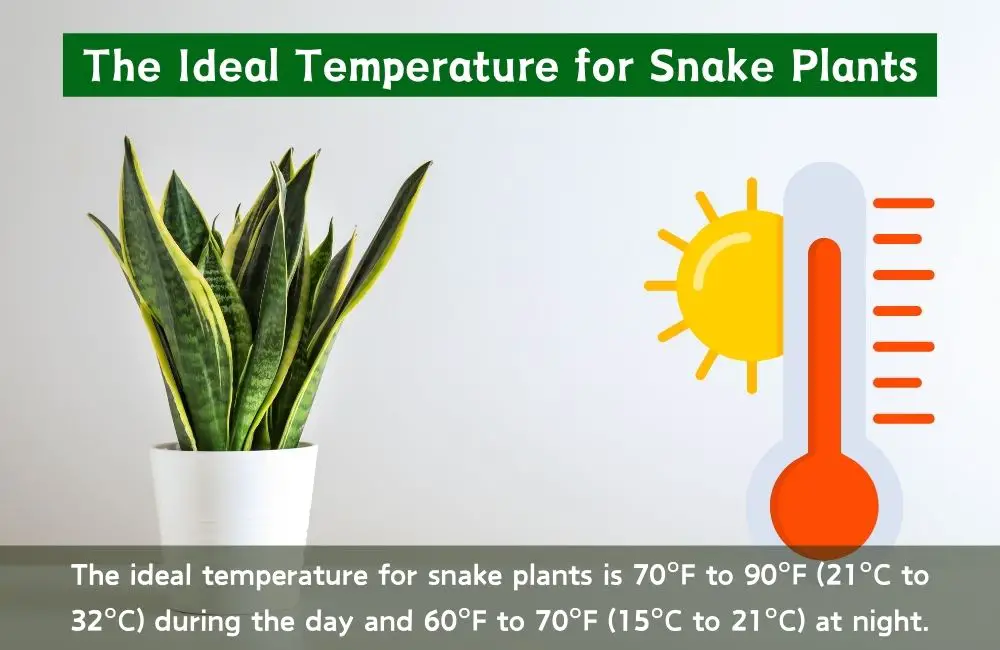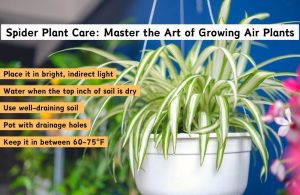This article covers the following areas –
- Ideal Daytime Temperatures
- Optimal Nighttime Temperatures
- Essential Summer Care Tips
- Winter Care Tips
- Managing Heat Stress
- Addressing Cold Damage
- Tips for Maintaining the Right Temperature
- Final Words
- Frequently Asked Questions
As a passionate indoor gardener, I’ve found that understanding the right temperature for my snake plants has been crucial to their health. This hardy, low-maintenance plant can thrive in various conditions, but knowing its temperature preferences can make a significant difference. Let me walk you through everything you need to know about the ideal temperature for your snake plant.
The ideal temperature for snake plants is 70°F to 90°F (21°C to 32°C) during the day and 60°F to 70°F (15°C to 21°C) at night. Keeping them within this range ensures healthy growth and vibrant foliage. Avoid temperatures below 50°F (10°C) to prevent cold damage.
Now that you know the perfect temperature for snake plants, we’ll dive deeper into how to maintain these conditions throughout the year. You’ll also learn about the effects of temperature extremes and practical tips to ensure your snake plant thrives in any season.
Ideal Daytime Temperatures
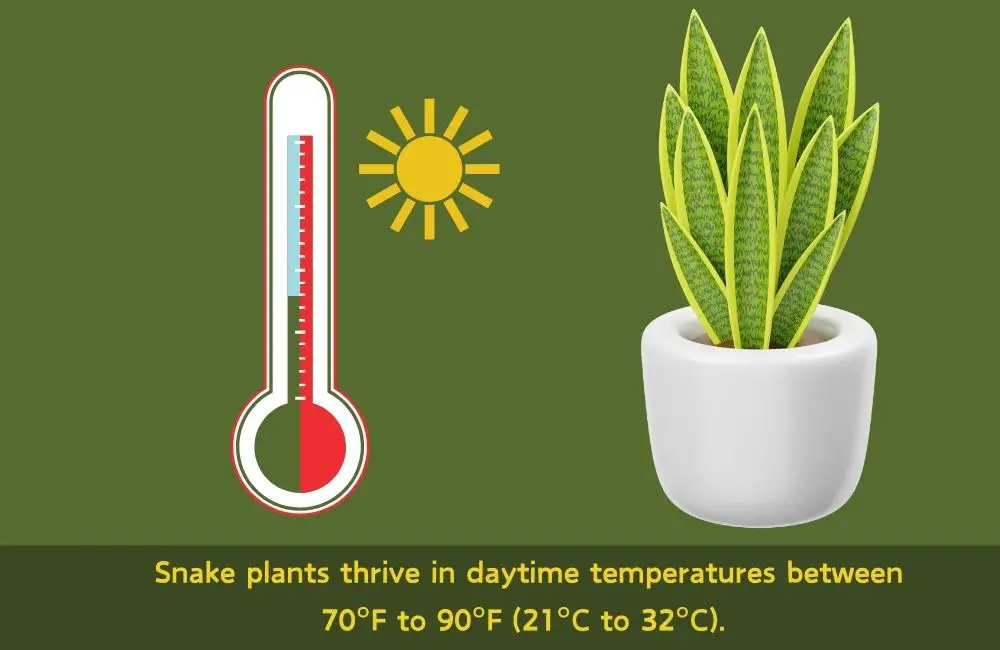
Snake plants thrive in daytime temperatures between 70°F to 90°F (21°C to 32°C). This range mimics their natural habitat, promoting healthy growth and vibrant foliage. Maintaining these temperatures ensures your snake plant stays robust and encourages new leaf development.
Providing the right warmth during the day is crucial for snake plants. These temperatures replicate the tropical conditions they naturally prefer. When kept within this range, snake plants can perform photosynthesis efficiently, which is vital for their growth.
In my experience, ensuring daytime temperatures remain consistent helps my snake plants flourish. I keep them in rooms where the temperature stays stable, avoiding places that get too hot or too cold. This consistent warmth makes a noticeable difference in their health.
I’ve noticed that my snake plants develop new leaves more rapidly when they enjoy the right daytime temperatures. The vibrant green color of the foliage is a sign that the plant is happy and healthy. Consistent warmth during the day encourages this lush growth.
To maintain these temperatures, I monitor my indoor environment carefully. Using a room thermometer helps me keep track of the temperature and make adjustments as needed. Simple steps like moving the plant away from direct sunlight during peak hours can prevent overheating.
Ensuring your snake plant has the right daytime temperatures is a simple but effective way to keep it thriving. With a little attention to its environment, your snake plant will reward you with beautiful, vibrant foliage.
Optimal Nighttime Temperatures
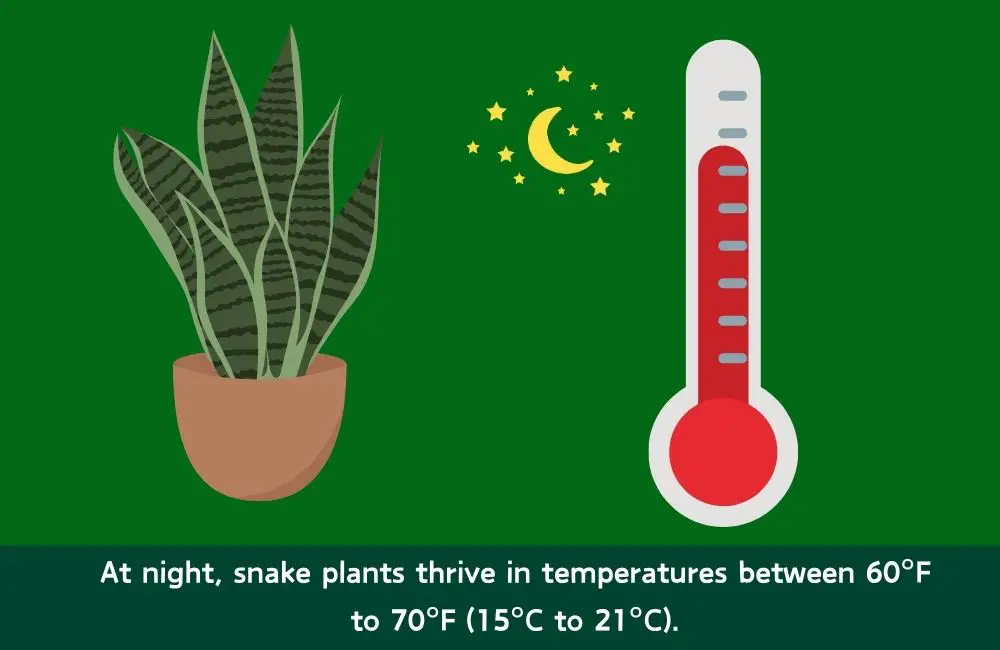
At night, snake plants thrive in temperatures between 60°F to 70°F (15°C to 21°C). This cooler range helps the plant rest and recover from daytime heat, promoting overall health and vibrancy. Keeping nighttime temperatures within this range ensures your snake plant remains robust and lively.
Providing the right nighttime temperatures is just as important as daytime warmth. Snake plants benefit from a slight drop in temperature at night, which mimics their natural environment. This cooler period helps the plant conserve energy and rejuvenate.
In my home, I ensure the nighttime temperature for my snake plants stays between 60°F to 70°F. I’ve noticed that when the temperature remains within this range, the plants look more vibrant and their leaves are healthier. This drop in temperature seems to refresh the plant, preparing it for the next day.
Keeping an eye on nighttime temperatures is simple. I use a thermometer to monitor the room’s temperature and make sure it’s not too cold or too warm. Avoiding drafts from windows or doors also helps maintain a consistent environment for the plants.
When temperatures dip too low at night, snake plants can suffer from cold stress. Symptoms include droopy or discolored leaves. By keeping nighttime temperatures within the ideal range, I prevent these issues and ensure my plants stay in top condition.
Maintaining the right nighttime temperature is a small but effective step in snake plant care. This cooler range allows the plant to rest properly, leading to overall better health and more vibrant growth.
Essential Summer Care Tips
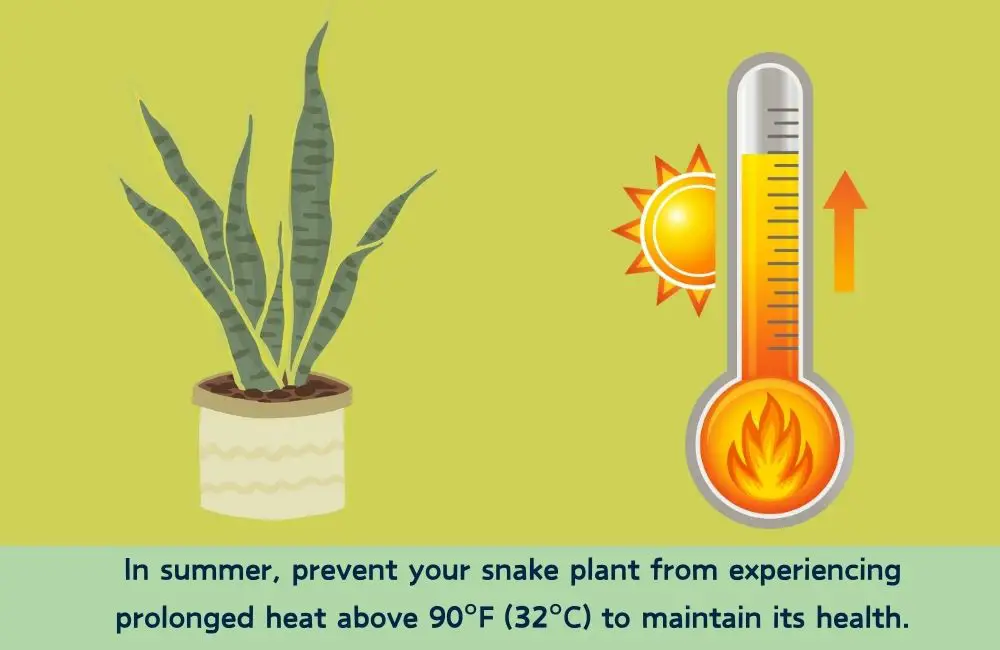
During the summer, keeping snake plants within their preferred temperature range is generally straightforward. However, extremely hot summers can pose a challenge. It’s crucial to prevent your snake plant from experiencing prolonged heat above 90°F (32°C) to maintain its health.
In areas with intense summer heat, I make it a point to move my snake plants away from direct sunlight during peak hours. Direct sunlight can significantly raise the temperature around the plant, causing potential heat stress. Shifting the plants to a shadier spot helps mitigate this risk.
I also ensure my snake plants receive adequate airflow during the summer. Proper ventilation can help dissipate excess heat and maintain a stable environment. Placing a fan near the plants or ensuring windows are open can enhance air circulation.
Additionally, I monitor the soil moisture levels closely during hot weather. While snake plants are drought-tolerant, extreme heat can dry out the soil quickly. Watering the plants more frequently, but not excessively, helps keep them hydrated without risking root rot.
If temperatures in your area consistently rise above 90°F (32°C), consider using sheer curtains or blinds to filter the sunlight. This simple step can reduce the heat intensity and protect your snake plants from overheating.
Taking these precautions during summer ensures that your snake plants stay healthy and vibrant. By managing heat exposure and maintaining proper hydration, you can help your plants thrive even in the hottest months.
Winter Care Tips
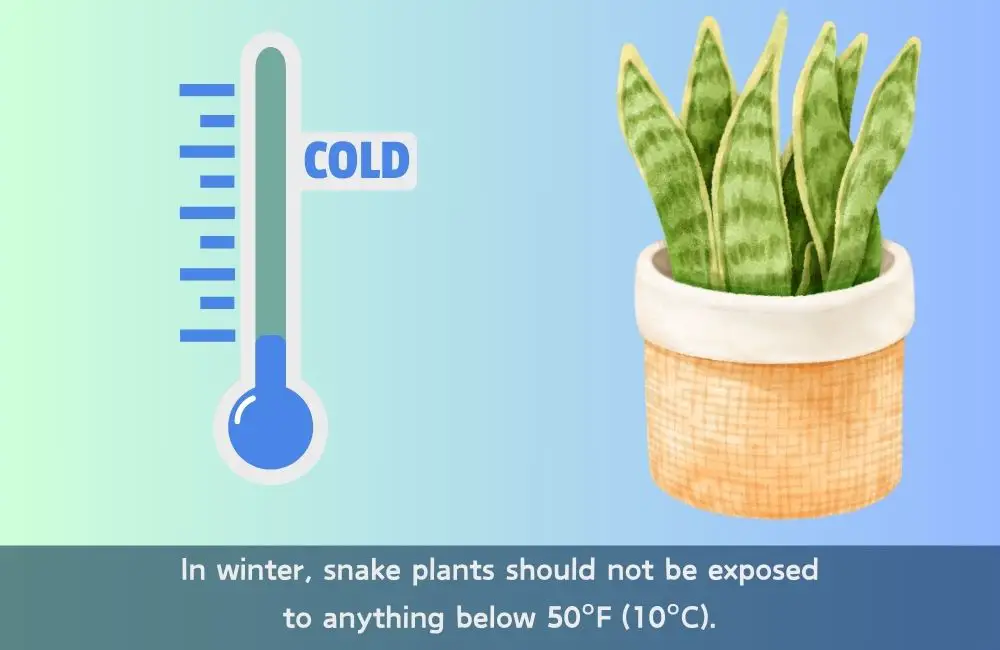
Winter can be a challenging season for indoor plants, including snake plants. They can tolerate cooler temperatures but should not be exposed to anything below 50°F (10°C). Ensuring your snake plants stay within a safe temperature range during winter is crucial for their health.
In my home, I take several steps to protect my snake plants from cold drafts. I keep them away from windows and doors that might let in chilly air. Drafts can quickly lower the temperature around the plants, causing stress and potential damage.
Using a room thermometer helps me monitor the temperature in different areas of my home. This simple tool ensures that I can keep track of the environment and make adjustments as needed. It’s especially useful during cold snaps when indoor temperatures can drop unexpectedly.
I also consider the placement of my snake plants in winter. I move them to spots that naturally stay warmer, such as interior rooms away from exterior walls. This helps maintain a more consistent temperature around the plants.
If the temperature in my home gets too cold, I use space heaters to provide additional warmth. However, I make sure not to place heaters too close to the plants to avoid overheating. Balancing warmth while avoiding direct heat sources is key.
Ensuring proper care during winter helps snake plants survive the colder months and stay healthy. By keeping them away from drafts, monitoring temperatures, and providing a stable environment, you can protect your plants from winter’s challenges and promote their well-being.
Managing Heat Stress
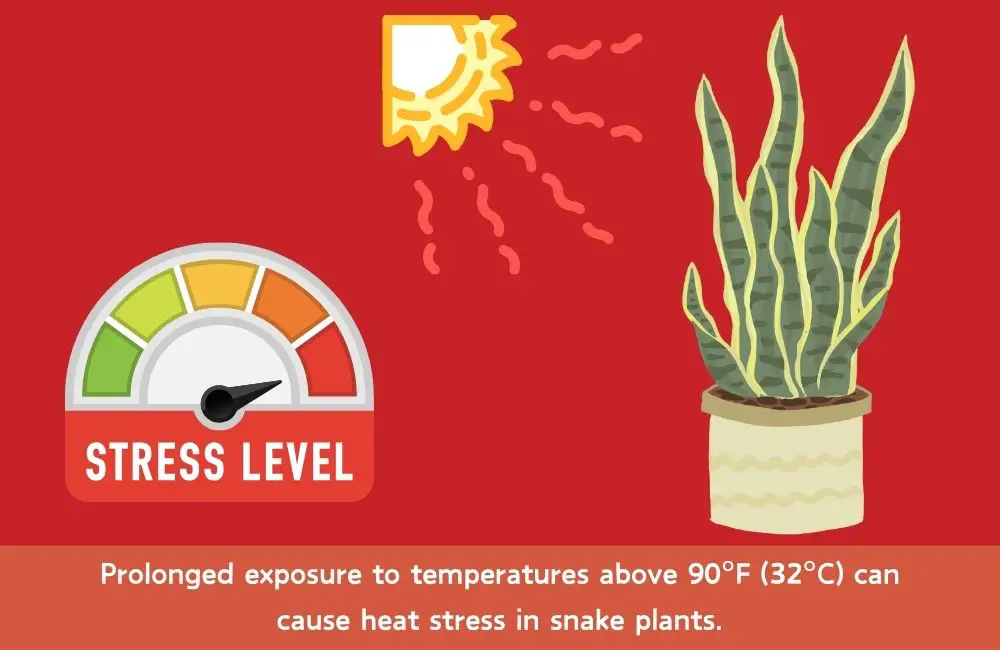
Prolonged exposure to temperatures above 90°F (32°C) can cause heat stress in snake plants. Heat stress manifests through symptoms such as wilting, yellowing leaves, and stunted growth. Recognizing these signs early and taking corrective actions is crucial for your plant’s recovery.
When snake plants experience heat stress, their leaves may begin to wilt. This is one of the first signs that your plant is struggling with excessive heat. If you notice wilting, it’s essential to act quickly to prevent further damage.
Yellowing leaves are another common symptom of heat stress. This discoloration occurs because the plant is unable to perform photosynthesis efficiently under extreme temperatures. In my experience, moving the plant to a cooler location immediately can help reverse this condition.
Stunted growth is a more long-term effect of heat stress. If your snake plant is not producing new leaves or the existing leaves appear smaller than usual, it could be a sign that the plant is stressed from high temperatures. Addressing this issue promptly can help the plant return to its normal growth pattern.
To help a heat-stressed snake plant recover, move it to a cooler area below 90°F (32°C). Increasing watering slightly can also help, as the plant needs more moisture to cope with the heat. However, be careful not to overwater, as this can lead to root rot.
Consistent care and monitoring temperature can prevent heat stress in snake plants. You can keep your plants healthy and thriving, even during hot weather, by ensuring they stay within their preferred temperature range.
Addressing Cold Damage
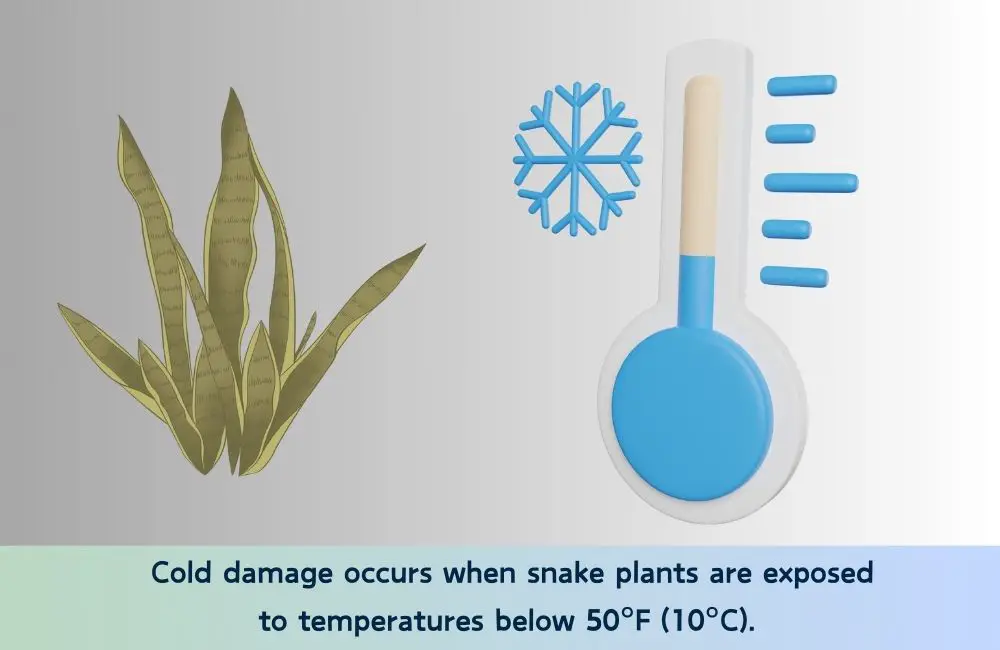
Cold damage occurs when snake plants are exposed to temperatures below 50°F (10°C). Symptoms of cold damage include brown, mushy leaves, and slowed growth. It’s important to act swiftly if you suspect your snake plant is suffering from cold damage.
Brown, mushy leaves indicate that your snake plant has been exposed to cold temperatures. The cold affects the plant’s cells, causing them to break down and become mushy. If you notice this symptom, immediate action is necessary to prevent further damage.
Slow growth indicates that your snake plant may be experiencing cold damage. When the temperature drops too low, the plant’s metabolic processes slow down, resulting in stunted growth. This is why keeping snake plants within their preferred temperature range is essential.
When I suspect cold damage in my snake plants, the first step I take is to move them to a warmer area. This helps stabilize their environment and prevents further exposure to cold temperatures. Ensuring the new location stays above 50°F (10°C) is key to their recovery.
Trimming any damaged leaves is also an important part of the recovery process. Removing brown, mushy leaves helps the plant focus its energy on healthy growth. I use clean, sharp scissors to make precise cuts, which helps prevent any potential infections.
Preventing cold damage is always better than dealing with its effects. By monitoring indoor temperatures, avoiding drafts, and providing a stable environment, you can protect your snake plants from the harmful impact of cold weather and keep them thriving year-round.
Tips for Maintaining the Right Temperature
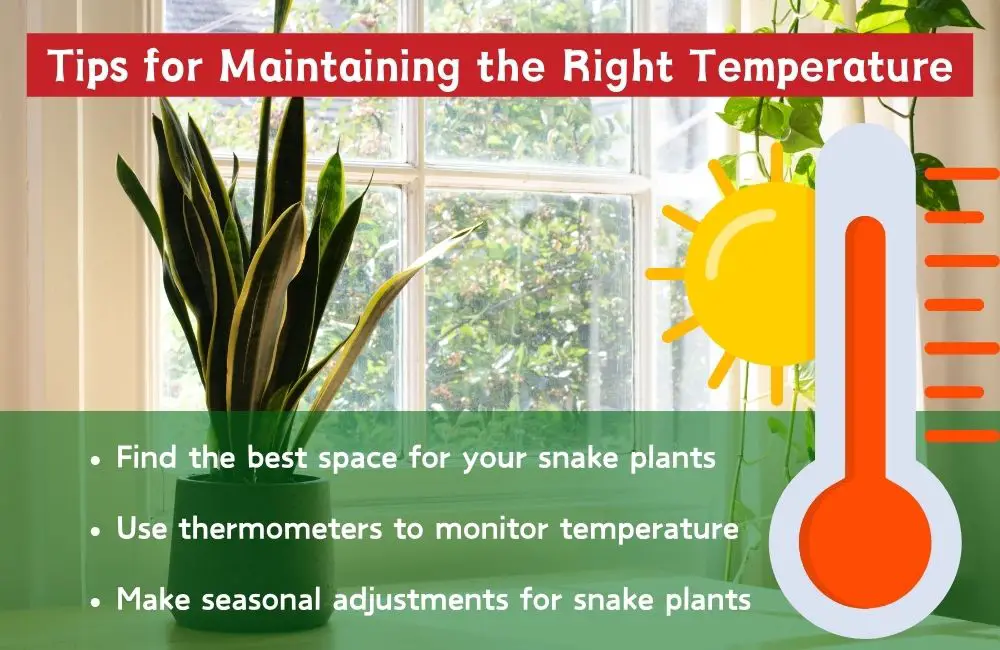
Maintaining the right temperature for snake plants is crucial for their health and growth. These hardy plants can thrive in various conditions, but providing the ideal temperature range ensures they stay vibrant and healthy. In this article, I’ll share practical tips on how to keep your snake plants at their best by maintaining the right temperature.
1. Find the Best Space
Choose a spot in your home that naturally stays within the optimal temperature range of 70°F to 90°F during the day and 60°F to 70°F at night. Placing snake plants in rooms with stable temperatures, like living rooms or bedrooms, helps them thrive. Avoid areas near heating or cooling vents to prevent sudden temperature changes.
Selecting the right location for your snake plant is crucial for maintaining a stable temperature. I’ve found that rooms with consistent temperatures, such as living rooms and bedrooms, are ideal. These areas usually avoid the fluctuations found in kitchens or bathrooms.
Avoid placing your snake plants near heating or cooling vents. The blasts of hot or cold air can create sudden temperature shifts that stress the plant. I always ensure my snake plants are positioned away from these areas to maintain a stable environment.
Consider the natural light in your chosen location as well. While snake plants tolerate low light, they still benefit from some indirect sunlight. A spot with moderate, filtered light helps the plant grow without overheating from direct sun.
If your home has areas with fluctuating temperatures, use room dividers or screens to create a more stable microclimate for your snake plants. This helps buffer against drafts and temperature swings, providing a more consistent environment for your plants to thrive.
By carefully choosing and optimizing the placement of your snake plants, you can ensure they stay healthy and vibrant. Consistent temperatures and avoiding sudden changes are key to their well-being.
2. Use Thermometers to Monitor Temperature
Using a simple room thermometer helps you monitor the temperature around your snake plants, ensuring their environment remains consistent. Keeping a thermometer near your plants lets you quickly notice any temperature fluctuations and make necessary adjustments to maintain optimal conditions.
A room thermometer is a practical tool for any plant enthusiast. By monitoring the temperature, you can ensure that your snake plants stay within their preferred range of 70°F to 90°F during the day and 60°F to 70°F at night. Consistent temperatures are crucial for the health and growth of your plants.
I always keep a thermometer close to my snake plants. This way, I can easily check the temperature day and night. If I notice any significant changes, I can immediately adjust the room’s heating or cooling settings to stabilize the environment.
A thermometer monitors the temperature and helps you understand how different areas of your home affect your plants. You might find that certain spots maintain more stable temperatures than others, allowing you to choose the best location for your snake plants.
Regularly checking the thermometer ensures that your snake plants are not exposed to extreme temperatures, which can cause stress and damage. Keeping an eye on the temperature can provide a comfortable and stable environment, helping your snake plants thrive.
3. Make Seasonal Adjustments for Snake Plants
Adjust the location of your snake plants with the changing seasons to ensure they remain in the optimal temperature range. In summer, move them to cooler spots if necessary, and in winter, ensure they are away from cold drafts to prevent temperature stress.
During the summer, temperatures can rise above the preferred range for snake plants, which is 70°F to 90°F. Consider relocating your snake plants to cooler areas if your home gets particularly warm. Moving them away from direct sunlight during peak hours helps prevent overheating.
Winter brings a different set of challenges. Snake plants should not be exposed to temperatures below 50°F. To protect them, I place my snake plants in interior rooms with more stable temperatures. Avoiding spots near drafty windows or doors is crucial to prevent cold damage.
Monitoring the temperature with a room thermometer can also help during seasonal transitions. You can make timely adjustments to your snake plants’ location by monitoring the environment. This proactive approach ensures they remain healthy throughout the year.
Seasonal adjustments are a simple yet effective way to care for your snake plants. By responding to changes in temperature and light, you can provide a consistent, nurturing environment that supports their growth and well-being.
Final Words
Understanding and maintaining the right temperature for snake plants is key to their health and longevity. By keeping them within their ideal temperature range, you’ll enjoy lush, vibrant plants all year round. With a little attention to their environment, snake plants can be a stunning and resilient addition to your indoor garden.
Frequently Asked Questions
The ideal daytime temperature for snake plants is between 70°F to 90°F (21°C to 32°C). This range ensures the plant can thrive and grow effectively.
The ideal nighttime temperature for snake plants is between 60°F to 70°F (15°C to 21°C). This cooler range helps the plant rest and recover from the day’s heat.
Snake plants should not be exposed to temperatures below 50°F (10°C). Exposure to such low temperatures can cause cold damage, resulting in brown, mushy leaves and slowed growth.
To prevent snake plants from overheating in summer, move them to cooler spots and away from direct sunlight during peak hours. Ensuring proper ventilation can also help maintain a stable environment.
Protect snake plants from cold drafts in winter by placing them in interior rooms away from windows and doors. Keeping them in a stable, warmer environment helps prevent cold damage.
Signs of heat stress in snake plants include wilting, yellowing leaves, and stunted growth. Moving the plant to a cooler location and slightly increasing watering can help it recover.
Signs of cold damage in snake plants include brown, mushy leaves and slowed growth. Moving the plant to a warmer area and trimming damaged leaves can help it recover.
Maintaining a consistent temperature for snake plants involves using a room thermometer to monitor their environment and adjusting to keep them within the optimal temperature range.
Place snake plants in rooms with stable temperatures, such as living rooms or bedrooms. Avoid areas near heating or cooling vents to prevent sudden temperature changes.
Adjust the location of snake plants with changing seasons by moving them to cooler spots in summer and ensuring they are away from cold drafts in winter. This helps maintain optimal growing conditions year-round.

